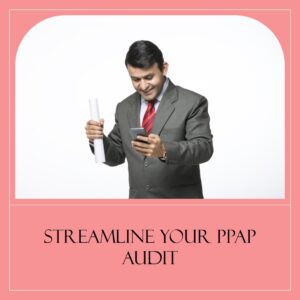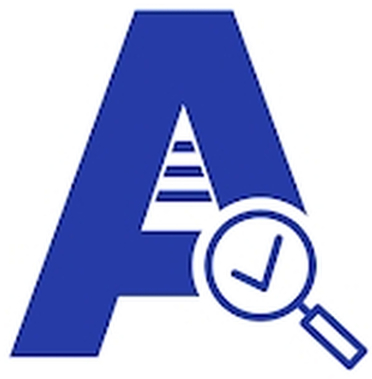PPAP Production Part Approval Process audit
Pre-purchase pre-shipment supplier audit, often referred to as PPAP Production Part Approval Process audit, is a comprehensive assessment conducted by a purchasing organization or quality control team before making a significant purchase from a supplier.
The primary goal of this audit is to evaluate the supplier’s capability to meet the quality, technical, and performance requirements of the products or services being procured. It ensures that the supplier is capable of delivering the desired goods or services consistently and with high quality. Here’s a breakdown of the key components and steps involved in a pre-purchase pre-shipment supplier audit:

Objective Definition
- Clearly define the objectives of the audit, including the specific quality, technical, and performance criteria that the supplier must meet.
Selection of Suppliers
- Identify and select potential suppliers based on factors like their reputation, past performance, capability, and ability to meet your requirements.
Audit Planning
- Develop an audit plan that outlines the scope, schedule, and audit team responsibilities.
Documentation Review
- Examine the supplier’s documentation, including quality control processes, production procedures, testing methods, and any relevant certifications.
On-Site Inspection
- Conduct an on-site visit to the supplier’s facility or manufacturing site. This involves physically inspecting the supplier’s operations, equipment, and processes.
- Observe the production process and verify that it aligns with the agreed-upon specifications and standards.
Quality Control Review
- Evaluate the supplier’s quality control systems, including process controls, inspection procedures, and defect tracking.
Product Testing and Validation
- If applicable, conduct product testing and validation to ensure that the products meet the required specifications and performance standards.
Supplier Capability Assessment
- Assess the supplier’s overall capability, including its technical expertise, workforce competence, and capacity to meet your production volume requirements.
Risk Assessment
- Identify and evaluate any potential risks associated with the supplier, such as supply chain vulnerabilities, financial stability, or geopolitical factors that could impact the supply.
Corrective Actions and Improvement Plans
- Work with the supplier to address any identified issues or non-conformities.
- Collaboratively develop corrective action plans to resolve deficiencies and improve the supplier’s processes.
Documentation and Reporting
- Document all audit findings, including both positive and negative observations.
- Prepare a comprehensive audit report that summarizes the findings and includes recommendations, corrective action plans, and timelines.
Supplier Communication
- Share the audit findings and recommendations with the supplier and establish clear expectations for improvements and ongoing monitoring.
Approval and Commitment
- Depending on the audit results, make a decision to approve the supplier for the purchase or negotiate additional terms and conditions.
Ongoing Monitoring
- Continue to monitor the supplier’s performance over time, especially if the audit has identified areas of improvement.
Documentation and Records Management
- Maintain records of the audit, including all documentation and correspondence, for future reference and compliance purposes.
A successful PPAP Production Part Approval Process audit – pre-purchase pre-shipment supplier audit helps organizations minimize risks, ensure product quality, and establish a strong supplier relationship. It allows the buyer to make informed decisions and provides a mechanism for continuous improvement in supplier performance.


Conducting a PPAP Production Part Approval Process audit using eAuditor Audits & Inspections can streamline the audit process, improve efficiency, and enhance data accuracy. PPAP is a structured approach used in the automotive industry and other manufacturing sectors to ensure that suppliers can consistently produce parts or components that meet quality and performance requirements. Here’s how you can use eAuditor Audits & Inspections for a PPAP audit:
Select the eAuditor Audits & Inspections
- You can obtain eAuditor Audits & Inspections from Apple or Android App store.
Define PPAP Requirements
- Clearly define the PPAP requirements and criteria that the supplier must meet. This includes specifications, quality standards, and documentation requirements.
Schedule Audits
- Use the eAuditor Audits & Inspectionsto schedule PPAP audits with suppliers. Assign auditors to specific audits and notify them through the app.
Conduct Audits
- Create PPAP Production Part Approval Process audit checklist in eAuditor Audits & Inspections.
- Auditors can use the eAuditor Audits & Inspectionsto conduct on-site or remote PPAP audits at supplier facilities.
- During the audit, auditors can input data directly into the eAuditor Audits & Inspections, including checklist responses, comments, and ratings.
- Capture photos or videos of relevant processes, equipment, or issues as evidence.
Real-Time Data Entry
- The eAuditor Audits & Inspectionsallows auditors to enter data in real-time, reducing the need for manual data entry later.
Generate PPAP Reports
- Once the PPAP audit is completed, eAuditor Audits & Inspectionsgenerates comprehensive reports summarizing the audit findings.
- Reports may include textual descriptions, numerical ratings, photos, and any other relevant data.
Review and Approval
- Relevant stakeholders can use eAuditor Audits & Inspectionsto review audit reports and make decisions based on the findings.
Supplier Feedback and Corrective Actions
- If non-compliance issues are identified during the PPAP audit, use eAuditor Audits & Inspectionsto communicate with the supplier and track corrective actions and timelines.
Secure Data Storage
- Ensure that PPAP audit data is securely stored and can be accessed only by authorized personnel.
Continuous Monitoring
- Use eAuditor Audits & Inspectionsto track and monitor supplier performance over time, especially as it relates to PPAP requirements and ongoing quality assurance.
Training and Support
- eAuditor Audits & Inspectionsprovides training and support to auditors on how to use effectively for PPAP audits.
Implementing eAuditor Audits & Inspections
for PPAP Production Part Approval Process audit can help organizations in manufacturing and related industries streamline the auditing process, improve data accuracy, and enhance communication with suppliers. It also facilitates real-time decision-making and ensures that PPAP Production Part Approval Process audit data is readily available for analysis and reporting, contributing to the overall quality assurance process.
